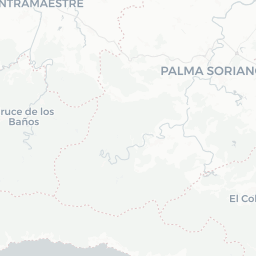A Journey to Faith Report: El Cobre [Eng/Esp]
6 comments

I have decided to share with you, my dear friends of #worldmappin, this kind of travelogue of a trip I took a while ago but which, due to its motivations and emotional weight, I had not shared. Today, when my country is threatened by one of the worst natural phenomena, I return to this journey that I made with much faith, to the National Shrine of the Virgen de la Caridad del Cobre.
Located just 20 km from the eastern city of Santiago de Cuba, this site, which I visited for the fourth time in my life, is a place of repeated pilgrimage for most Cubans who, moved by faith, go to visit this sanctuary where the Virgen del Cobre, Patron Saint of Cuba, is safeguarded.

To travel from my province to there, one must cover around 400 km, steep roads, mountainous landscapes, and endure the harsh eastern sun. But when one travels with motivation, a firm purpose, and a clean soul, those kilometers can become almost nothing.

Many people travel there to fulfill promises, ask for the well-being of their loved ones, or simply to demonstrate their faith towards the most revered figure by Cubans. On this fourth occasion that I traveled to the sanctuary, I was accompanying my parents who were indeed fulfilling a promise.

Located with the Shrine Church on top of a hill, it is accompanied by a large staircase, although it also has an entrance at its rear, which we had to use this time because the doors of the great staircase were closed. Legend has it that this Virgin was found by three fishermen in the Bay of Nipe after a great storm, and they took her to a town from which she mysteriously disappeared and was found on the hill of El Cobre. The third time this happened, it was taken as a sign that the virgin definitively wanted to rest on top of the hill, and the beautiful church that safeguards her was later built.



The current Shrine building has Renaissance architecture, with two towers, and upon entering, the most important thing is the image of the virgin high up, protected by glass and covered in jewels and gold. This image has the ability to rotate, and on this occasion, it was facing the rear altar through which we entered.


The vases of impressive beauty and the religious images accompany this impressive church.




The numerous stained-glass windows tell the story of the discovery of the virgin and its significance for all the Cuban people.



The sanctuary is famous for the large collection of offerings that the faithful have left to the virgin over the centuries in gratitude for miracles granted. Although this time we could not see them, it is said that one of the most famous offerings is the Nobel Prize in Literature medal donated by Ernest Hemingway in 1954.



When we left the church, we took some time to admire the surrounding landscape. You can see the mountainous landscape, the copper mines, and the famous Monument to the Cimarrón.



Near the Sanctuary, you can see the hostel where pilgrims can spend the night.

If all the magic that surrounds the place is impressive, so is the crowd of artisans that line the edges of the road selling small reproductions of the virgin, this being the way for everyone to take a virgin to their home, and one of the ways to remember the magnificent trip made.



The adoration of the virgin transcends races, social classes, and even beliefs. She is venerated equally by Catholics and by practitioners of the syncretic religion: Santería, where she is identified as Ochún, the orisha of love, the river, and femininity.
After showing you this journey, believe me, it has been like traveling again that path full of faith and hope.
Until the next trip!

✨ 𝑻𝒉𝒂𝒏𝒌𝒔 𝒇𝒐𝒓 𝒓𝒆𝒂𝒅𝒊𝒏𝒈! ✨
𝑰𝒇 𝒚𝒐𝒖 𝒅𝒐𝒏’𝒕 𝒌𝒏𝒐𝒘 𝒎𝒆 𝒚𝒆𝒕, 𝑰’𝒎 𝒂 𝑪𝒖𝒃𝒂𝒏 𝒏𝒆𝒖𝒓𝒐𝒍𝒐𝒈𝒊𝒔𝒕 𝒂𝒏𝒅 𝒘𝒓𝒊𝒕𝒆𝒓, 𝒂 𝒎𝒐𝒕𝒉𝒆𝒓, 𝒂 𝒘𝒐𝒎𝒂𝒏, 𝒂𝒏𝒅 𝒂 𝒅𝒓𝒆𝒂𝒎𝒆𝒓 𝒘𝒉𝒐’𝒔 𝒇𝒐𝒖𝒏𝒅 𝒊𝒏 𝑯𝒊𝒗𝒆 𝒂 𝒃𝒆𝒂𝒖𝒕𝒊𝒇𝒖𝒍 𝒔𝒑𝒂𝒄𝒆 𝒕𝒐 𝒔𝒐𝒂𝒓.
𝑨𝒍𝒍 𝒕𝒆𝒙𝒕 𝒂𝒏𝒅 𝒊𝒎𝒂𝒈𝒆𝒔 𝒂𝒓𝒆 𝒎𝒚 𝒐𝒓𝒊𝒈𝒊𝒏𝒂𝒍 𝒄𝒓𝒆𝒂𝒕𝒊𝒐𝒏𝒔, 100% 𝒉𝒖𝒎𝒂𝒏-𝒎𝒂𝒅𝒆 (𝒏𝒐 𝑨𝑰).
𝑩𝒂𝒏𝒏𝒆𝒓 𝒅𝒆𝒔𝒊𝒈𝒏𝒆𝒅 𝒃𝒚 𝑳𝒖𝒎𝒊𝒊.
𝑳𝒐𝒗𝒆𝒅 𝒕𝒉𝒊𝒔 𝒑𝒐𝒔𝒕? 𝑼𝒑𝒗𝒐𝒕𝒆, 𝒄𝒐𝒎𝒎𝒆𝒏𝒕, 𝒐𝒓 𝒓𝒆𝒃𝒍𝒐𝒈 𝒕𝒐 𝒔𝒑𝒓𝒆𝒂𝒅 𝒕𝒉𝒆 𝒘𝒊𝒏𝒈𝒔 𝒐𝒇 𝒄𝒓𝒆𝒂𝒕𝒊𝒗𝒊𝒕𝒚! 💛

VERSIÓN EN ESPAÑOL

Reportaje de un viaje a la fe: El Cobre

Me he decidido a compartir con ustedes, amigos entrañables de #worldmappin, esta suerte de reportaje de un viaje que hice hace un tiempo pero que por las motivaciones del mismo y la carga sentimental no había compartido. Hoy, cuando mi país se ve amenazado por uno de los peores fenómenos naturales, regreso a este recorrido que hice con mucha fe, hasta el Santuario Nacional de la Virgen de la Caridad del Cobre.
Ubicado solo a 20 km de la oriental ciudad de Santiago de Cuba, este sitio, al que llegué por cuarta ocasión en mi vida, es lugar de repetida peregrinación para la mayoría de los cubanos que, movidos por la fe, van a visitar este santuario donde se resguarda la Virgen del Cobre, Patrona de Cuba.

Para viajar desde mi provincia hasta allá, hay que recorrer alrededor de 400 km, carreteras empinadas, paisajes montañosos y someterse al rudo sol oriental. Pero cuando se viaja motivado, con un propósito firme y con el alma limpia, esos kilómetros se pueden volver casi nada.

Muchas personas viajan hasta allá para cumplir promesas, pedir por la suerte de las personas queridas o simplemente para demostrar la fe hacia la figura más venerada por los cubanos. En esta cuarta ocasión que viajé hasta el santuario, lo hacía acompañando a mis padres, que sí iban en cumplimiento de una promesa.

Ubicada la Iglesia Santuario en lo alto de un cerro, está acompañada de una gran escalinata, aunque también tiene una entrada en su parte posterior por donde esta vez debimos entrar, pues las puertas de la gran escalinata estaban cerradas. Cuenta la leyenda que esta Virgen fue encontrada por tres pescadores en la Bahía de Nipe, después de una gran tormenta, y la llevaron hasta un poblado del que misteriosamente desaparecía y era encontrada en el cerro del Cobre. A la tercera vez de estos hechos, se tomó como que la virgen quería definitivamente reposar en lo alto del cerro, construyéndose luego la bella iglesia que la resguarda.



El edificio actual del Santuario tiene una arquitectura renacentista, con dos torres, y al entrar lo más importante es la imagen de la virgen en lo alto, protegida por cristal y cubierta por joyas y oro. Esta imagen tiene la facultad de girar, y en esta ocasión miraba hacia el altar posterior por donde entramos.


Los jarrones de una belleza impresionante y las imágenes religiosas acompañan esta iglesia impresionante.




Los vitrales, dispuestos en gran número, cuentan la historia del hallazgo de la virgen y la significación para todo el pueblo cubano.



El santuario es famoso por la gran colección de ofrendas que los fieles han dejado a la virgen a lo largo de los siglos en agradecimiento de los milagros concedidos. Aunque esta vez no pudimos verlas, se habla de que una de las ofrendas más famosas es la medalla del Premio Nobel de Literatura de Ernest Hemingway, que donó en 1954.



Cuando salimos de la iglesia, nos tomamos un tiempo para admirar el paisaje que nos circundaba. Se puede ver el paisaje montañoso, las minas de cobre y el famoso monumento al Cimarrón.



Cercano al Santuario, se puede ver el hostal donde los peregrinos pueden pernoctar.

Si impresionante es toda la magia que rodea al lugar, también lo es el cúmulo de artesanos que llenan los bordes de la carretera vendiendo pequeñas reproducciones de la virgen, siendo esta la forma de que todos se lleven una virgen hasta su hogar, y una de las formas de recordar el magnífico viaje realizado.



La adoración a la virgen trasciende razas, clases sociales e incluso creencias. Es venerada por igual por católicos como por practicantes de la religión sincrética: santería, donde ella se identifica como Ochún, la orisha del amor, el río y la feminidad.
Después de mostrarles este viaje, créanme que ha sido como volver a recorrer ese camino lleno de fe y esperanza.
¡Hasta el próximo viaje!

✨ ¡𝑮𝒓𝒂𝒄𝒊𝒂𝒔 𝒑𝒐𝒓 𝒍𝒆𝒆𝒓! ✨
𝑺𝒊 𝒂ú𝒏 𝒏𝒐 𝒎𝒆 𝒄𝒐𝒏𝒐𝒄𝒆𝒔: 𝒔𝒐𝒚 𝒏𝒆𝒖𝒓ó𝒍𝒐𝒈𝒂 𝒚 𝒆𝒔𝒄𝒓𝒊𝒕𝒐𝒓𝒂 𝒄𝒖𝒃𝒂𝒏𝒂, 𝒎𝒂𝒅𝒓𝒆, 𝒎𝒖𝒋𝒆𝒓 𝒚 𝒔𝒐ñ𝒂𝒅𝒐𝒓𝒂 𝒒𝒖𝒆 𝒆𝒏𝒄𝒐𝒏𝒕𝒓ó 𝒆𝒏 𝑯𝒊𝒗𝒆 𝒖𝒏 𝒉𝒆𝒓𝒎𝒐𝒔𝒐 𝒆𝒔𝒑𝒂𝒄𝒊𝒐 𝒑𝒂𝒓𝒂 𝒗𝒐𝒍𝒂𝒓.
𝑬𝒍 𝒕𝒆𝒙𝒕𝒐 𝒚 𝒍𝒂𝒔 𝒊𝒎á𝒈𝒆𝒏𝒆𝒔 𝒔𝒐𝒏 𝒅𝒆 𝒎𝒊 𝒂𝒖𝒕𝒐𝒓í𝒂, 100% 𝒉𝒖𝒎𝒂𝒏𝒐𝒔 (𝒔𝒊𝒏 𝑰𝑨).
𝑩𝒂𝒏𝒏𝒆𝒓 𝒅𝒊𝒔𝒆ñ𝒂𝒅𝒐 𝒑𝒐𝒓 𝑳𝒖𝒎𝒊𝒊.
¿𝑻𝒆 𝒈𝒖𝒔𝒕ó 𝒆𝒔𝒕𝒂 𝒑𝒖𝒃𝒍𝒊𝒄𝒂𝒄𝒊ó𝒏? 𝑽𝒐𝒕𝒂, 𝒄𝒐𝒎𝒆𝒏𝒕𝒂 𝒐 𝒓𝒆𝒃𝒍𝒐𝒈𝒖𝒆𝒂 𝒑𝒂𝒓𝒂 𝒂𝒚𝒖𝒅𝒂𝒓 𝒂 𝒅𝒆𝒔𝒑𝒍𝒆𝒈𝒂𝒓 𝒆𝒔𝒕𝒂𝒔 𝒂𝒍𝒂𝒔. 💛





Comments